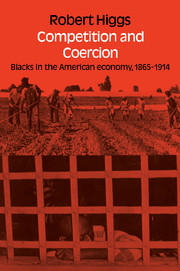Book contents
- Frontmatter
- Contents
- List of tables
- Preface
- “Race” and “racial discrimination”: A prefatory note on usage
- 1 Approaching the facts
- 2 The people
- 3 The people at work, 1865–1880
- 4 The people at work, 1880–1914
- 5 The fruits of their labors
- 6 Overview and interpretation
- Technical appendix
- Notes
- Select bibliography
- Index
4 - The people at work, 1880–1914
Published online by Cambridge University Press: 07 October 2011
- Frontmatter
- Contents
- List of tables
- Preface
- “Race” and “racial discrimination”: A prefatory note on usage
- 1 Approaching the facts
- 2 The people
- 3 The people at work, 1865–1880
- 4 The people at work, 1880–1914
- 5 The fruits of their labors
- 6 Overview and interpretation
- Technical appendix
- Notes
- Select bibliography
- Index
Summary
Industry is competing with agriculture for the limited supply of Negro workers. Negroes, responding to exactly the same natural laws that control the white farmers, have been moving cityward, entering other occupations, migrating west or north—where more money is to be made. Agricultural wages have therefore gone up and rents, relatively, have gone down.
Ray Stannard Baker, 1908If living by the sweat of the brow was an indication of man's fall from grace, then black people truly labored under the curse. In 1890, when the census first made racial distinctions in the returns pertaining to gainful employment, the blacks reported a relatively high involvement in gainful pursuits; and during the following 20 years their measured rate of participation in the labor force increased substantially (see Table 4.1). Some of the increase, particularly for females, was probably spurious, reflecting more careful enumeration in the last census. But part of the increase was probably genuine, for the age structure of the population was changing in a way that favored greater participation in the labor market. In 1890 persons aged 10–14 made up about 20 percent of the population aged 10 or more; by 1910 their share had fallen to about 16 percent. In addition, the share of persons aged 15–19 fell by about two percentage points during this period. These changes meant that persons relatively less involved in the labor market were becoming less heavily represented in the population of potential working age.
- Type
- Chapter
- Information
- Competition and CoercionBlacks in the American economy 1865-1914, pp. 62 - 94Publisher: Cambridge University PressPrint publication year: 1977

